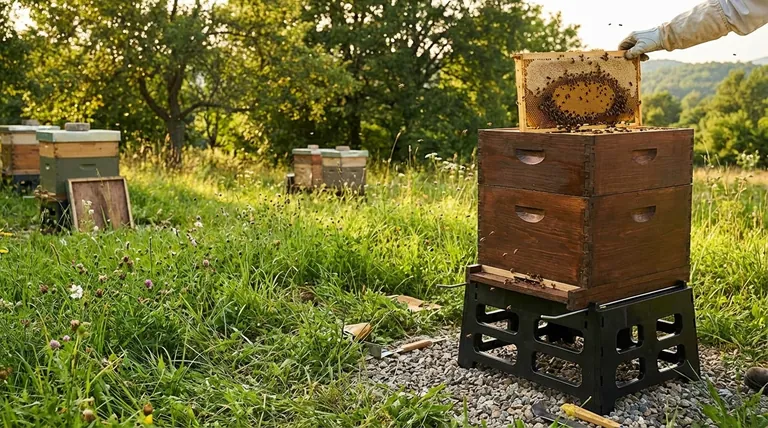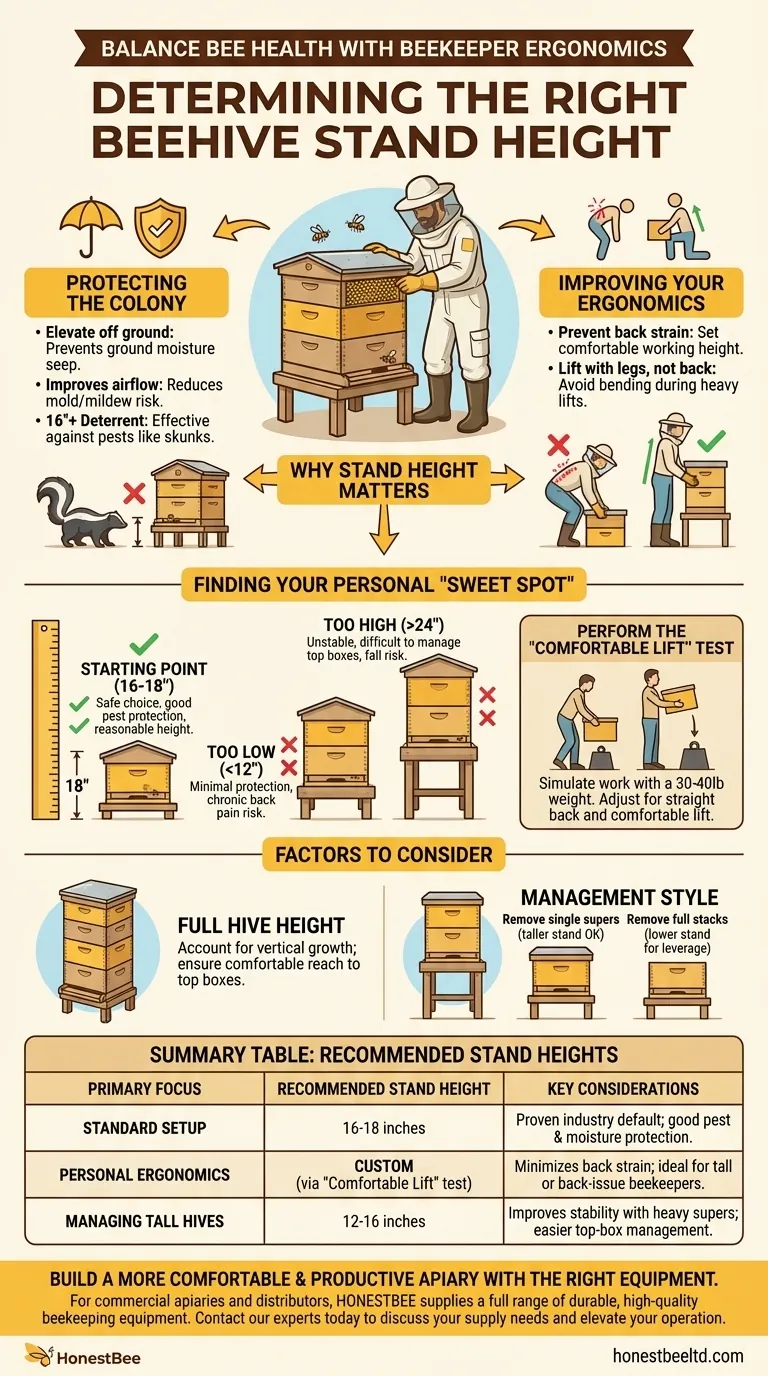Determining the right beehive stand height is a critical decision that balances bee health with beekeeper ergonomics. While the common recommendation is a height of 16 to 18 inches, this is merely a starting point. The optimal height is a personalized measurement that must account for your body, your management style, and the maximum expected height of your hive.
The core challenge is not finding a single "correct" height, but rather an ergonomic sweet spot. The ideal stand prevents you from straining your back while lifting heavy boxes and simultaneously protects your colony from ground-level moisture and pests.

Why Stand Height is More Than Just a Number
Choosing a stand height has direct consequences for both the colony's well-being and your physical health as a beekeeper. It's a foundational decision that impacts all future hive work.
Protecting the Colony
A primary function of the stand is to elevate the hive off the ground. This elevation provides crucial protection from ground moisture, which can seep into the wood and create poor internal hive conditions. It also improves airflow beneath the bottom board, reducing the risk of mold and mildew.
Furthermore, a stand of at least 16 inches is an effective deterrent against pests like skunks, which prey on bees at the hive entrance and can be a significant nuisance.
Improving Your Ergonomics
Beekeeping is a physical activity. A hive inspection requires you to bend over the boxes, and harvesting involves lifting supers that can weigh 50-80 pounds or more.
Setting your stand at a comfortable working height is the single best thing you can do to prevent back strain. A stand that is too low forces you to bend excessively, while one at the correct height allows you to lift with your legs, not your back.
Accounting for Full Hive Height
Remember that a hive grows vertically. A stand that seems perfect for a single brood box in the spring may become problematic when the hive is five or six boxes tall.
You must be able to comfortably reach and manipulate the top boxes without overextending. A hive that is too tall becomes unstable and difficult to manage safely.
Finding Your Personal "Sweet Spot"
The 16 to 18-inch guideline is popular because it works well for a person of average height managing a standard Langstroth hive. Use this as your baseline and adjust from there.
Start with the 18-Inch Guideline
For most new beekeepers, building or buying a stand that places the bottom of the hive around 18 inches off the ground is a safe and effective choice. It provides excellent pest protection and a reasonable working height.
Perform the "Comfortable Lift" Test
The most accurate way to find your ideal height is to simulate the work. Stack empty boxes or other objects to 18 inches and place a 30-40 pound weight on top. Practice lifting it.
Is the motion comfortable? Do you feel strain in your lower back? Adjust the height up or down by a few inches until you find the level that allows for a straight back and a comfortable, leg-driven lift. This is your personal ergonomic height.
Factor in Your Management Style
Consider how you manage your hives. If you always remove honey supers one by one before they get excessively heavy, a slightly taller stand may be fine.
If you prefer to remove a full, heavy stack at once, a lower stand might provide better leverage and stability.
Understanding the Trade-offs
Every decision in beekeeping involves balancing competing factors. Stand height is no different.
The Risk of Going Too Low
A stand below 12 inches offers minimal protection from moisture and makes the hive an easy target for skunks. More importantly, it will force you to constantly bend over during inspections, leading to chronic back pain.
The Risk of Going Too High
A stand that is too tall (e.g., over 24 inches) creates a new set of problems. The hive can become top-heavy and unstable, especially when full of honey.
Lifting heavy supers to or from a high perch increases the risk of dropping them or losing your balance, which is dangerous for both you and the bees. It also makes inspecting the top boxes difficult without a step stool.
Making the Right Choice for Your Apiary
Select your stand height with a long-term view of your apiary and your physical well-being.
- If your primary focus is a standard, straightforward setup: Start with a 16 to 18-inch stand, as this is the proven industry default.
- If your primary focus is personal ergonomics (e.g., you are very tall or have back issues): Use the "Comfortable Lift" test to find the precise height that minimizes strain for your body.
- If your primary focus is managing very tall, productive hives: Consider a slightly lower stand (12-16 inches) to ensure top-box stability and make lifting heavy supers more manageable.
By prioritizing an ergonomic design from the start, you create a sustainable system that protects your body and allows you to enjoy beekeeping for years to come.
Summary Table:
| Primary Focus | Recommended Stand Height | Key Considerations |
|---|---|---|
| Standard Setup | 16-18 inches | Proven industry default; good pest & moisture protection. |
| Personal Ergonomics | Custom (via "Comfortable Lift" test) | Minimizes back strain; ideal for tall beekeepers or those with back issues. |
| Managing Tall Hives | 12-16 inches | Improves stability with heavy supers; easier top-box management. |
Build a more comfortable and productive apiary with the right equipment. The correct beehive stand height is just the beginning. For commercial apiaries and distributors, having access to durable, high-quality beekeeping supplies is essential for operational success. HONESTBEE supplies a full range of beekeeping equipment through our wholesale-focused operations, helping you protect your colonies and your team's well-being. Contact our experts today to discuss your supply needs and elevate your beekeeping operation.
Visual Guide

Related Products
- Plastic Bee Hive Stand for Beekeeping
- Metal Hive Feet Bee Hive Stand for Ant Protection
- Metal Bee Hive Stand Bee Box Stand for Beekeeping
- Wholesales Dadant Size Wooden Bee Hives for Beekeeping
- Professional Drop-Style Hive Handles for Beekeeping
People Also Ask
- How does the longevity of plastic bee hives compare to wooden hives? Discover the Durable Choice
- How do bees regulate the temperature of their hive during the summer? Discover Their Natural Cooling System
- What are the advantages of a second hive if the queen is killed? The Ultimate Insurance Policy for Your Apiary
- What is the purpose of a hive stand in a Langstroth hive? Protect Your Hive and Boost Colony Health
- How do plastic bee hives compare to wooden hives in handling? Reduce Strain & Boost Efficiency



















